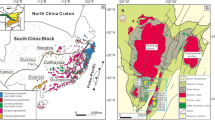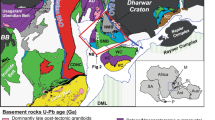Abstract
The age of the trans-Himalayan calk-alkaline magmatism has not been clearly established: on the basis of geological control, it is possible to infer a pre-late Cretaceous age for the plutonites at the southern edge of the batholith belt, and a late Cretaceous or younger age for the lava series on the top and/or to the north of the plutons. K–Ar radiometric data previously obtained by Chinese groups agree with these geological ages. The 39Ar–40Ar method has been used to analyse more accurately some of the rocks which have been sampled during the joint French–Chinese field work in southern Tibet in the summer of 1980:the incremental degassing of argon gives generally more information about the thermal history of the sample. Using this method we now show that the earlier basic plutons of the southern edge of the trans-Himalayan belt have ages of 90–110 Myr (Albian to Cenomanian), whereas the lavas of the upper unconformable series are clearly younger (60 Myr, Palaeocene). The Ladakh and Kohistan magmatic belts further west are probable equivalents of the trans-Himalaya, north of the Indus suture. Their precise ages are also poorly known: Orbitolinas of middle Cretaceous (Aptian) age have been found in the Drosh–Yasin series which lie unconformably on dioritic plutons in the northern edge of the belt. The few radiometric data that are available give ages in fairly good agreement with those we have obtained in the trans-Himalaya. So we conclude that a subduction zone has been active during the Cretaceous between India and Asia. The only outstanding question is whether this active margin was, at that time, close to India, or to Asia, or somewhere in between.
This is a preview of subscription content, access via your institution
Access options
Subscribe to this journal
Receive 51 print issues and online access
$199.00 per year
only $3.90 per issue
Buy this article
- Purchase on Springer Link
- Instant access to full article PDF
Prices may be subject to local taxes which are calculated during checkout
Similar content being viewed by others
References
Jin Cheng-wei & Zhou Yun-sheng Scient. Geol. Sin. 4, 297–311 (1978).
Shackleton, R. M. J. struct. Geol. 3, 97 (1981).
Liu Guan-jian & Zhang Kui-wu Proc. Symp. on Qinghai-Xizang (Tibet) Plateau, Beijing 1, 451 (Science, 1981).
Zhang Bing-gao & Mu Xi-nan J. Stratigr. 3, 65–66 (1979) (in chinese).
The K-Ar Isotopic Age Group, Scient. Geol. Sin. 1 (1981).
Zhang Yu-quan, Dai Tong-mo & Hong A-shi. Proc. Symp. on Qinghai-Xizang (Tibet) Plateau, Beijing 483 (China, Science Press, 1981).
Maluski, H. Geochim. cosmochim. Acta 42, 1619–1663 (1978).
Brookfield, M. E. & Reynolds, P. H. Earth planet. Sci. Lett. 55, 157–162 (1981).
Author information
Authors and Affiliations
Rights and permissions
About this article
Cite this article
Maluski, H., Proust, F. & Xiao, X. 39Ar/40 Ar dating of the trans-Himalayan calc-alkaline magmatism of southern Tibet. Nature 298, 152–154 (1982). https://doi.org/10.1038/298152a0
Received:
Accepted:
Issue Date:
DOI: https://doi.org/10.1038/298152a0
This article is cited by
-
Determination of In Situ Stress by Inversion in a Superlong Tunnel Site Based on the Variation Law of Stress — A Case Study
KSCE Journal of Civil Engineering (2023)
-
An alternative tectonic model for the Yarlung Zangbo suture zone
Science in China Series D: Earth Sciences (2010)
-
Geochronology and petrogenesis of granitic rocks in Gangdese batholith, southern Tibet
Science in China Series D: Earth Sciences (2009)
-
40Ar-39Ar geochronology of Cenozoic Linzizong volcanic rocks from Linzhou Basin, Tibet, China, and their geological implications
Chinese Science Bulletin (2004)
-
Tectonic setting discrimination and40Ar/39Ar isotope geochronology of the Miba granite
Science in China Series B: Chemistry (2002)
Comments
By submitting a comment you agree to abide by our Terms and Community Guidelines. If you find something abusive or that does not comply with our terms or guidelines please flag it as inappropriate.



